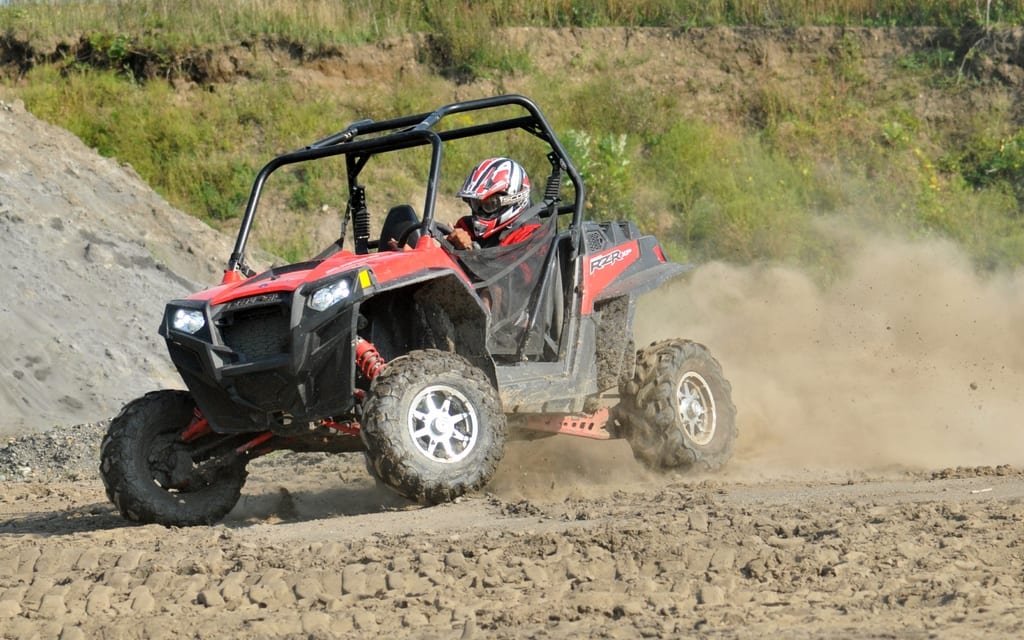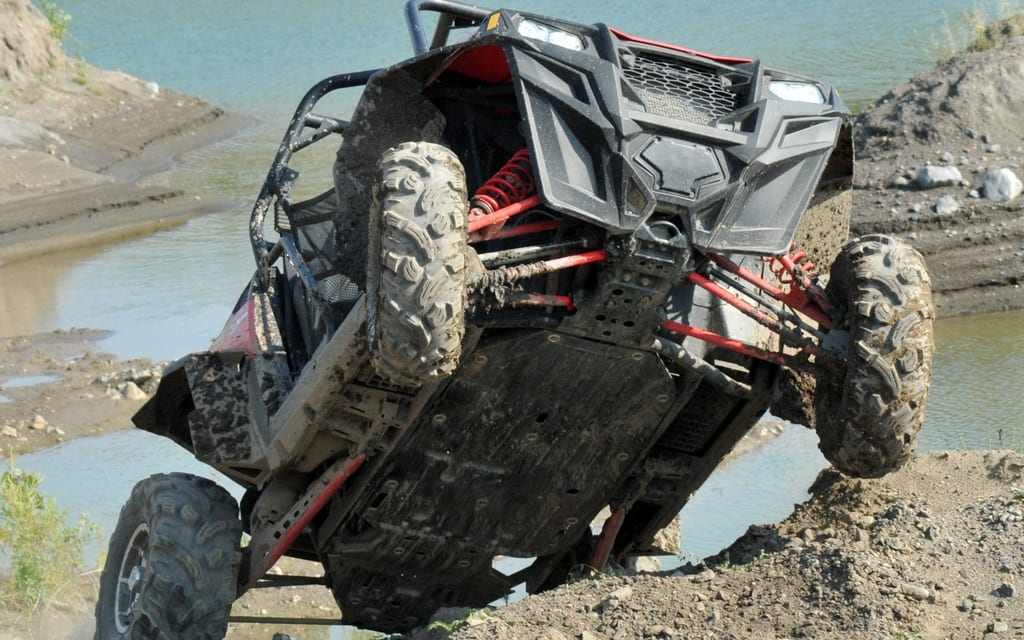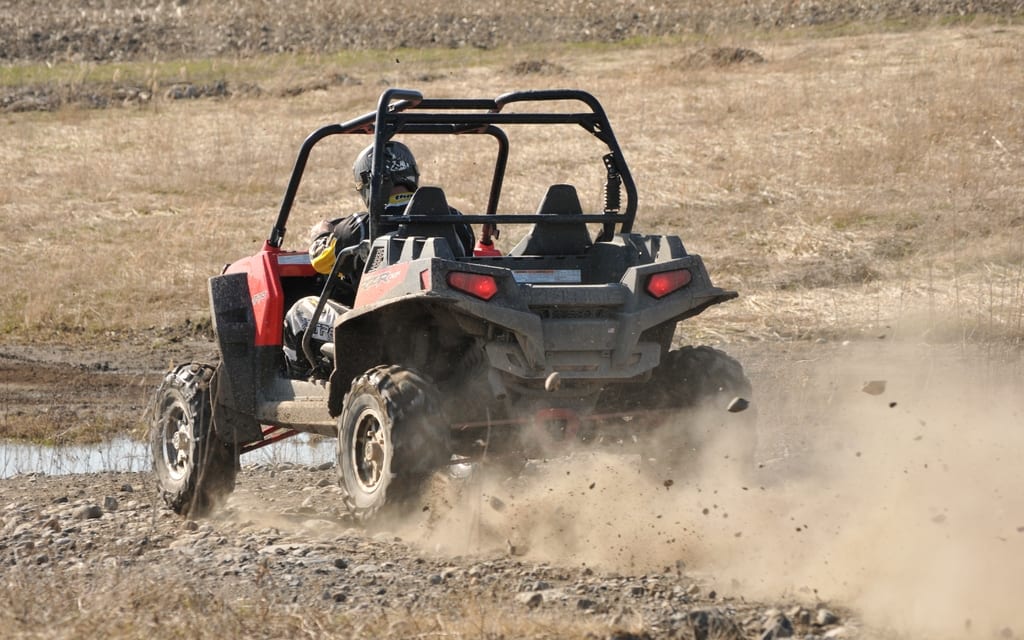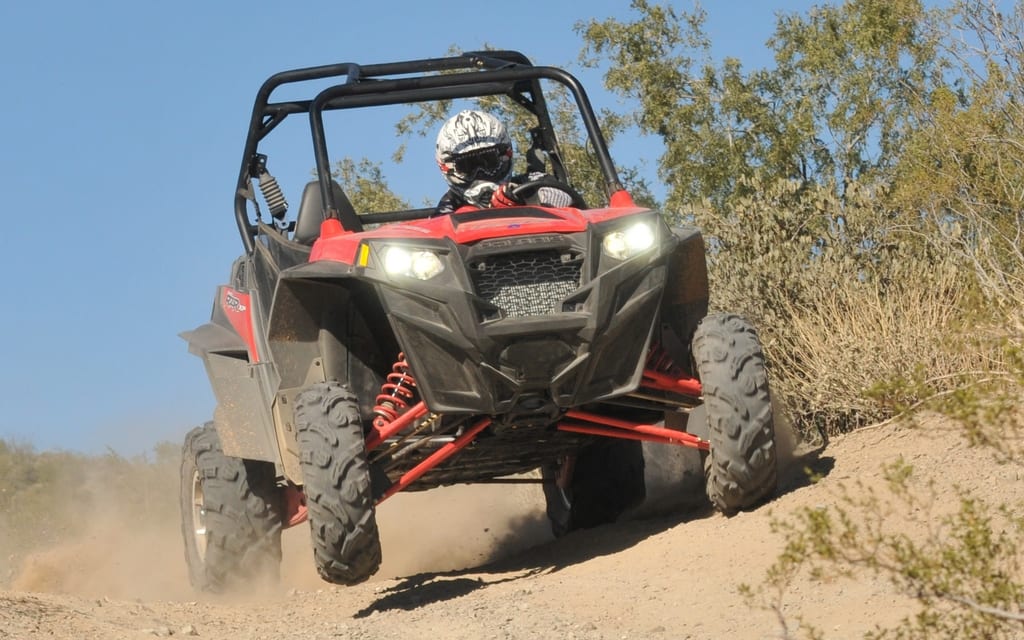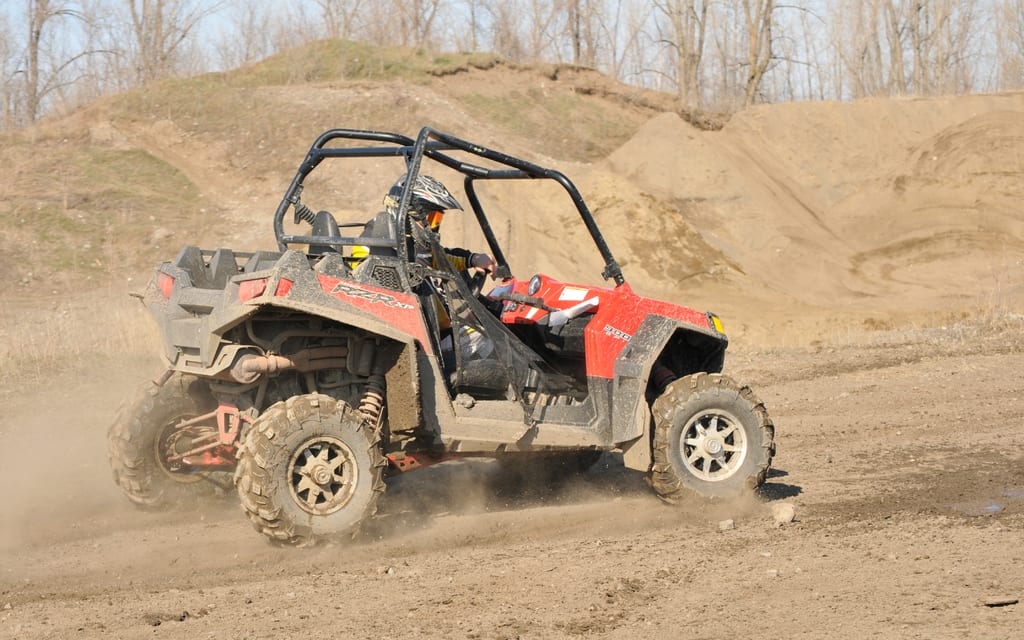Don’t be fooled by the numbers, most would expect this 900 to be just a tad more powerful and a little more able than the already gratifying Ranger RZR-S. Nothing could be further from the truth; this is one vehicle you must experience at least once in your life. A glance will suffice to notice that this is a much upgraded RZR, but experiencing its great power and stability hands on, as you keep a strong hold of the steering or the passenger grab bar, will reveal a lot more than expected from any Side X Side.
Specifically and purpose-built for this new type of extreme performance Side x Side, the Polaris ProStar™ 900 DOHC Twin EFI engine offers an industry-leading 88 HP, which pushed me back in the seat like nothing I had ever driven off road. This high revving engine with compact design, truly sets it in a class of its own. Although the RZR-S remains an attractive ride for thrill seekers, it is left in the dust when compared with this one. So much so, that testing it to its full potential can be a challenging task. Racing world knowledge can certainly be a good thing to have, if one wants to fully enjoy this incredibly fast and able toy. Power and acceleration is truly on demand, while braking is extremely efficient, and so one needs to be quick with his feet and should use both, to get the most out of this awesome ride.
Given the fact that rally racing or Baja is totally up my alley, this thing was simply, heaven sent. We just had to try it in as many different conditions we could find. First, was last winter’s abundant snow to conquer, and it did that in a spectacular fashion. Imagine the joy when my good friend Ben, gave me the ok to try and open up his pristinely kept horseback riding trail. It had taken him a while, but once I reassured him that I would back out of it right away, if I felt I was punching through the snow too much and consequently causing damage in his flat trail, he gave me the green flag. So, Fitto and I plunged in the woods. The white blanket, only disturbed by a few hare tracks crossing the trail, was a good two feet thick. This snow was very densely packed from recent thawing. The buggy was rolling forward like there was nothing to that. Let me add that, everybody I know who owns a 4×4 quad were not even thinking of going out riding in these impossible conditions. As I kept a fun pace, some of the fresher snow on top, would mist up and over the hood, encouraging joyful reactions from my high-performance hungry passenger. Yahoo! I think he was saying.
The suspension’s true capacity and awesome power delivery of the all-new ProStar 900 engine, would remain to be discovered. For now, they proved themselves to be more than enough for these slippery conditions, and the tires’ efficiency was the crucial element. They could have put the more than decent Bighorn 2.0 tires from Maxxis on this RZR as well, but the riding characteristics demanded something more adapted to this ride’s power-generous feel on flatter and much dryer grounds. So, ITP was approached to design tires, specifically and exclusively for this ride. The resulting 900 X CT 27 inch rubbers are very nice; offering a whole lot of traction, which was proved during this very telling first experience in the thick snow, while giving just the right amount of directional capacity, during intensely negotiated curves in less snow.
Whatever surface or place where this baby rolls, snapping in the 4WD mode transforms it into an absolute terrain-conquering beast! There is a huge difference felt right away as all four tires work their magic in propelling you back deep in the seat. The power output of the new ProStar 900 is so aggressive that you must be in 4WD to truly feel all of it.
The generous 13 inches of ground clearance were a noticeable advantage in the snow. The ride wasn’t really gathering snow in front, it rather just glided over the top few inches most of the time, or simply pulverised all of it, on some occasions. All of this propels the fun factor to never before experienced heights. The thrill factor was even more intense, when we took it out on the same trail in the evening. Its factory LED headlights, yet another industry first, shine a high-intensity bright white beam that created constant scenery, rather than just lighting the trail up ahead. They throw light forward, far beyond conventional halogens. Trust me, nothing else can punch through a snow filled trail like this thing and it truly had me feel excitement I hadn’t experienced, since the early days with my Yamaha TRI-Z 250.
Springtime came and there was no dead period. I soon discovered its efficiency, no matter what lays underneath it; even the mud ridden trails at Saison Express, another of our favourite spots to test, for its wonderfully varied conditions in one small trail system. Getting there is just as fun and telling of a ride’s performance, suspension wise. The almost never-ending series of whoops, along the abandoned railway used to reach this tiny ATVing paradise, has become a great tool for me to figure out a vehicle’s ability to conquer obstacles in close succession (otherwise known as whoops). I usually push any and all the rides I am lucky enough to test, to the maximum safe speed possible through here, stabilizing to a rate just under what starts to feel unnerving. The RZR-4 had so far been the best and fastest through this section, so much so that negotiating it hardly took any skill as a driver and the faster I went, the smoother it made things.
It also gave the giggles to any passenger, no matter what age or gender. With this much more able XP 900, the entire bumpy run became uneventful; too little of a challenge for this ride to truly test the suspension’s ability. Now, I know that a lot of people are already going against manufacturers’ recommendations and are jumping with Side x Side vehicles. Truth is, this here vehicle and its predecessor, the RZR-S, are just about the only ones in this segment to offer enough of a good suspension to do so smoothly and safely. I still think it’s the last move anyone should be doing, even more so, if one just tries it on a whim, spotting a bump and deciding to floor it to see how it flies. The shape and condition of a jump determines its safety. I will explain the basic needs for the completion of such a stunt in a safe manner, mostly so all understand how tricky it can be. First of all, the length and angle in the ramp are extremely important.
A bump is not a jump and should never be conquered in an aggressive fashion. Don’t be fooled into thinking that there is no danger because it is only a small jump, and you have seen others clearing spectacular distance, making it seem like a piece of cake. The most spectacular version could very well be the safer one. On too small of a ramp, instead of making the entire vehicle jump in a smooth levelled manner, the front, and then back, will jump separately. The rear wheels will be launched upwards, creating too much front roll effect, and causing the front bumper to dangerously come close to the ground upon landing. The length and smoothness of the ramp are crucial; the entire vehicle must fit on the ramp. All four wheels must be able to roll fairly smoothly for a short moment before the vehicle is launched to fly levelled. Also crucial, is to not let off the throttle while the rear wheels are still on the ramp. Hesitating and lifting off the pedal too early, will also cause front roll.
Again, I’m hoping all of you understand that my point here is that jumping with any vehicle is not something to be taken lightly. The fact is that the RZR XP can perform such feats better than any other, which means a comfort level that is exponentially better than any other ride during normal use. You just can’t find any other “bone stock” off road vehicle that can cradle you so smoothly over rough terrain.
Consisting of two extra-long radius rods and a far forward-connecting trailing arm, the 3-Link design of the all-new Trailing Arm Independent Rear Suspension smoothed out obstacles like nothing else I had ever tried, and made most obstacles uneventful. Absolutely nothing that we would throw at it was affecting the handling. The 14 inches of travel, coupled with an astounding 13” of ground clearance, made most of our usual test beds, totally obsolete and useless! 4-Wheel hydraulic disc with dual-bore front calipers make this amazingly smooth, but somewhat aggressive buggy stop on a dime, yet offering the driver a good amount of feel under the foot. This trait would become more apparent, when I would later get a chance to drive it with my two feet, in full rally racing mode.
Maintenance is super easy, thanks to access panels in the cargo box, one for the air filter and another smaller one to access the oil check and filler cap. Oddly enough, the 14 inches of travel from the 3-link trailing arm rear suspension and 13.5 inches with the double A-arm setup in front, mean that the vehicle is so high up that everything you might want to access, is pretty much right there in plain view and easily reached. For the same reason, it is much easier to clean all that mud from the back of the wheels and keep an eye on the condition of many parts. You will need to take all that generous travel into consideration, when you tie your XP down and crank a quality ratchet strap at every corner, until the suspension is, at least, halfway through the travel, or else the straps will unhook when you hit bumps.
Where could we go to truly put this ride to the test? Standing some 10 feet behind the vehicle, I catch it grinning at me. The protective panel on its laterally positioned exhaust was creating this illusion. It seemed like it was confidently ready for anything. Finding some new testing grounds with the right kind of challenges was a must. A few rings here and there, and my good friend Fox and I decided on the most complete spot one could ask for, when in need of various off roading challenges: Mecaglisse, a motorsport complex with a sandy ATV race track, a bunch of rally racing circuits, and where X-Fest would be presented soon, partly on the main asphalt track. Superquad racing, hum, I wonder if…Side x Side? Superquad track?
ITP certainly knows its rubber and did a real good job when designing these. The exclusive ITP 900 XCT tires provided excellent grip on every surface we played on so far. The amazing handling, power and stability, I am very familiar with by now, and when Frank the Event Organizer and owner of this testing paradise, asked if I would take my red dune beast out on the Supermoto track for a few laps during intermission, I immediately accepted. I don’t think I expected it to be so spectacular. To be honest, I don’t think anybody did, until I was on the gas, negotiating my first curve on the burning hot asphalt. What a pleasant surprise it was to feel the rear-end slide out just a tad in a very smooth and controlled fashion, exactly as it did while riding off road. I made a wise choice to stay in 2WD. Sort of felt badly for the tires, but my confidence in the whole package grew at every turn. Wow! What a feeling! Here I am giving these people a cool drifting show, with a Side x Side! The crowd was cheering, my tires singing an odd song. Don’t anybody pinch me, if I’m dreaming leave me be.
I did go against manufacturer recommendations, which do say, clearly printed just to the left of the somewhat plain-looking steering wheel: “Do not operate on pavement”. Adding that this can seriously affect handling and control. I totally agree, but I’m not sure that it affects it in a negative fashion at all, in the case of this specific model only. I certainly don’t encourage anyone to use this product in a non-recommended fashion, but I think we can assume that this warning label is the same for all models and that it’s fair to consider it to be less of a necessity, as the width of the models increases. I would not have attempted this with a basic 50 inch wide RZR, maybe with the RZR-S and I might just have proved the label wrong to my witnesses there that day, with this 64 inches wide model. I used the same basic approach I do for off road, which I like to call: preventive and defensive driving.
It is sort of a philosophy of mine, in order to stay safe even when I’m pushing the envelope. The preventive part means wearing all of the right safety gear. More importantly a good helmet, buckling the safety belt, and pretty much try to do everything you think can be done to improve safety, before you head out. The defensive part is more directly linked with the physics of your vehicle in motion. Anyone can ride any vehicle safely, if it is kept well below its breaking point. An important concept to understand is that this point can change positions on the speed scale, as the vehicle is exposed to different types of challenges. For example, when a vehicle is operated on a slope, the breaking point of wheels wanting to leave the ground will be reached at a much lower speed. To make my concept clear, another example would be the point when grip from the tires is lost. In this vehicle’s case, in pretty much all intense situations we had experienced with it, those breaking points were at speeds most won’t feel comfortable in reaching, anyway. That’s how good it is.
Being smooth and gradual with my input on the brakes, as well as with my movements with the steering wheel, permitted me to feel where the limit was, all through the entrance of those turns on the hot pavement. The rest was a piece of cake! Coming out of turns is something this baby just does naturally, almost without any input from the driver. Actually, once I was past the apex of a turn, I could literally floor it and the vehicle placed itself smoothly into a drift, counter steered on its own, and pretty much did all the work of coming out with the most efficiency, with barely any input needed on my part. I would relax my grip on the wheel and simply enjoy the ride. I think I felt safer and more confident on the track, than when on the more unpredictable and ever changing ground conditions in the off road world.
A small crowd of curious race fans was gathering around the vehicle, with pertinent questions like: “Did you modify the suspension?”; “Do you have a turbo?” Totally stock! I replied, with a certain level of pride, even if it wasn’t really my ride.
Nothing but joy came out of these XP experiments, and never did the vehicle let us down in any way during this very long testing period. With its amazingly fully adjustable Fox shocks, it is easily adaptable to different ground conditions, and a sport quad user, familiar with race quad suspension adjustments, can truly enjoy optimizing this fun-inducing machine to its full potential. That being said, although I was tempted to tighten the rear spring preload, just before my pavement experiment, it was left alone, as set from the factory. One usually makes changes only when one feels they are needed. I simply never felt a need to change anything, even on the non-recommended pavement.
For more information on the above mentioned models, please visit the Polaris Website
More from Polaris on ATV Trail Rider :
Polaris ATV Models – Polaris UTV Models – Polaris ATV Reviews – Polaris UTV Reviews


